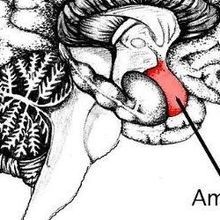amygdala

A Brain MicroRNA Curbs Anxiety
Mariella Bodemeier Loayza Careaga, PhD | Aug 1, 2023 | 2 min read
Upregulation of a specific microRNA in the brain lessened anxiety and reduced the expression of stress-related genes in mice.

Do Invertebrates Have Emotions?
Natalia Mesa, PhD | May 26, 2022 | 10+ min read
And how do scientists go about answering that question?

Another Reason to Challenge Yourself at the Gym
Alara Tuncer | 4 min read
In a chronic stress model, challenging exercise reduced anxiety by activating a three-neuron loop across brain regions.

Eight Weeks of Meditation Doesn’t Change the Brain, Study Finds
Natalia Mesa, PhD | May 20, 2022 | 4 min read
Study finds that, contrary to what other research has found, a popular meditation course does not appear to alter brain structure.

Epigenome Editing Decreases Alcohol Seeking and Anxiety in Rats
Natalia Mesa, PhD | May 20, 2022 | 4 min read
A CRISPR-based system that reverses epigenetic changes caused by adolescent binge drinking reduces adult addiction-like behaviors in rats, a study finds, suggesting that an epigenomic approach could someday help treat people with alcohol use disorder.

Infographic: Pathways from Noise to Cardiovascular Damage
Thomas Münzel and Omar Hahad | Jun 1, 2021 | 2 min read
Research in mice and humans points to oxidative stress and inflammation as likely drivers of noise-induced health effects such as hypertension and heart disease.

Broken Heart Syndrome Linked to the Brain
Amanda Heidt | Jun 1, 2021 | 2 min read
A chronically stressed amygdala can prime the heart to overreact to acute stress events, a new study shows.

Brain Circuitry for Fear and Anxiety Is the Same on fMRI
Amanda Heidt | Sep 21, 2020 | 5 min read
A study in people fails to detect differences in the brain’s response to fear or anxiety, long thought to be controlled by different neural circuits.

Infographic: What Social Isolation Can Mean for the Brain
Catherine Offord | Jul 13, 2020 | 1 min read
People who show low social engagement over long periods of time often show reductions in cognitive function. Studies of the brain may provide clues about this correlation.

Karaoke-Sleep Study Links Disrupted REM With Poor Memory Processing
Katarina Zimmer | Jul 11, 2019 | 5 min read
An unusual experiment suggests that interrupted REM sleep can interfere with the amygdala’s ability to process emotional memories overnight—in this case, the distressing memories of listening to oneself sing out of tune.

Defeating Fear Depends on Amygdala Suppression
Sukanya Charuchandra | Nov 1, 2018 | 1 min read
Researchers determine the neurological mechanics underpinning a technique to extinguish fearful memories using goal-directed eye movements.

Distinct Regions Drive Responses to Anxiety, Fear
Catherine Offord | Jan 1, 2018 | 2 min read
Researchers map brain activity associated with a person’s anticipation of or direct confrontation with danger.

Infographic: Anticipation Versus Confrontation
Catherine Offord | Dec 31, 2017 | 1 min read
The brain is activated differently when it’s contemplating, rather than directly facing, a threat.

Contributors
Jef Akst and Bob Grant | Nov 1, 2017 | 3 min read
Meet some of the people featured in the November 2017 issue of The Scientist.

Image of the Day: Fear Center
The Scientist and The Scientist Staff | Oct 26, 2017 | 1 min read
A set of neurons in the brain’s central amygdala plays a key role in forming memories of aversive experiences, scientists find in mice.

The Cellular Hallmarks of Consciousness
Anna Azvolinsky | Sep 21, 2017 | 4 min read
Recording from single neurons of epilepsy patients, neuroscientists show that both the strength and timing of neuronal firing are important to consciously perceive a visual object.

Scientists Activate Predatory Instinct in Mice
Diana Kwon | Jan 15, 2017 | 1 min read
A new study reveals how the amygdala is involved in controlling predatory behavior in mice.

Lying Repetitively Linked to Decreased Amygdala Activity
Kerry Grens | Oct 25, 2016 | 1 min read
As people continue to tell tall tales, fMRI data show certain brain regions become less busy.

Why Screams Scare Us
Jef Akst | Jul 20, 2015 | 1 min read
Analyzing the acoustical qualities of screams and other sounds, researchers pinpoint why people find screams—and emergency vehicle sirens—frightening.
